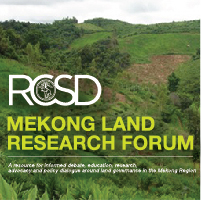Location
The purpose of the Mekong Land Research Forum online site is to provide structured access to published and unpublished research on land issues in the Mekong Region. It is based on the premise that debates and decisions around land governance can be enhanced by drawing on the considerable volume of research, documented experience and action-based reflection that is available. The online site seeks to organise the combined work of many researchers, practitioners and policy advocates around key themes relevant to the land security, and hence well-being, of smallholders in Cambodia, Laos, Myanmar, Thailand and Vietnam.
The research material on this site is mounted at three levels:
First, a selection of journal articles, reports and other materials is provided and organised thematically to assist researchers, practitioners and policy advocates to draw on one another’s work and hence build up a collective body of knowledge. This is the most “passive” presentation of the research material; our contribution is to find and select the most relevant material and to organise it into key themes. In some cases the entire article is available. In others, for copyright reasons, only an abstract or summary is available and users will need to access documents through the relevant journal or organisation.
Second, a sub-set of the articles has been annotated, with overall commentary on the significance of the article and the research on which it is based, plus commentary relevant to each of the key themes addressed by the article.
Third, the findings and key messages of the annotated articles are synthesised into summaries of each of fourteen key themes. For each key theme, there is a one-page overall summary. Extended summaries are being developed progressively for each theme as part of the Forum's ongoing activity.
Overall, we intend that this online site will contribute toward evidence-based progressive policy reform in the key area of land governance. We further hope that it will thereby contribute toward to the well-being of the rural poor, ethnic minorities and women in particular, who face disadvantage in making a living as a result of insecure land tenure.
Members:
Resources
Displaying 146 - 150 of 564Politics of Land Grabbing in the Borderland: A Case Study of Chongjom Border Market, Kabcheong District, Surin Province
Chongjom border is a contested area which reflects power-related relationship between center and its marginal space. From deserted borderland in the buffer zone during Khmer Rouge period, Chongjom becomes an emerging 4th ranking of cross-border trading between Thailand and Cambodia, where value of exporting goods have been increased up to 224.05 % in 2013. The politics of changes in land use and property relations change lead to widen of land grabbing in the area.
Convergence under pressure: Different routes to private ownership through land reforms in four Mekong countries (Myanmar, Cambodia, Laos, Vietnam)
WEBSITE INTRODUCTION: This paper aims to provide keys that will help us understand contemporary land dynamics in these four countries. In order to do so it highlights their similarities and differences, both in the long history that shaped today’s local land situations and in more recent reforms implemented in the context of greater economic openness. The first part of the paper sets the cultural and historical context, with an overview of the diverse ways that the political authorities and different groups within the region have related to land.
Different Regions, Different Reasons? Comparing Chinese land-consuming outward investments in Southeast Asia and Sub-Saharan Africa
Research indicates that key parameters of “land grabbing” differ across regions (e.g., ILC 2012) – particularly in view of who invests and/or when the bulk of investments occurred. At the same time, my review of the “land grab” literature since 2008 reveals that hardly any comparative assessments of “land grabbing” from a home country perspective exist that study whether and/or in which way and why “land grabs” of a single investor country differ across regions.
Land Acquisitions in Northeastern Cambodia: Space and Time matters
Over the last decade, the highlands of Ratanakiri province in northeastern Cambodia have witnessed massive land acquisitions and profound land use changes, mostly from forest covers to rubber plantation, which has contributed to rapidly and profoundly transform the livelihoods of smallholders relying primarily on family-based farming. Based on village- and households-level case studies in two districts of the province, this paper analyses this process and its mid-term consequences on local livelihoods. We first look at who has acquired land, where, how and at what pace.
Politics of Land Grabbing in the Borderland: A Case Study of Chongjom Border Market, Kabcheong District, Surin Province
Chongjom border is a contested area which reflects power-related relationship between center and its marginal space. From deserted borderland in the buffer zone during Khmer Rouge period, Chongjom becomes an emerging 4th ranking of cross-border trading between Thailand and Cambodia, where value of exporting goods have been increased up to 224.05 % in 2013. The politics of changes in land use and property relations change lead to widen of land grabbing in the area.


